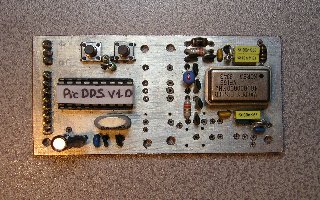Hardware
Software
Details
It appears that the receiver design allows for a quick and easy modification by reusing the frequency switch, the XTal sockets and the external diversity frequency input. The use of a -10V power supply (germanium transistors design) requires to use a dedicated power supply.
The AD-9835 DDS is driven by a PIC 16F84 which runs a polling loop looking for any frequency switch or push button changes.
Default frequencies are stored inside the PIC EEPROM and can be modified (5Hz up/down) by using any of the two push buttons.
I manage to reuse the XTal oscillator variable condensator to drive the push button inputs using two micro-switches and a metal clip put on the condensator axle.
The PIC is clocked using a 3.579545Mhz Xtal in order to get the 4800 Bauds RS232 speed.
For this application, the fixed frequencies have been hardcoded to receive the Hamburg RTTY 50Bd/450Hz weather programs on 4583.1KHz (DDK2), 7646.1Khz (DDH7), 10100.8KHz (DDK9), 11039.0Khz (DDH9) and 14467.3KHz (DDH8).
Pictures
Here, the MMIC and the output HF connector have not been yet soldered.
Push buttons allow to raise or lower the currently selected frequency.
| Prototype Copper side | Prototype Components side |
 |
 |
PicDDS board has been easily integrated in the RF520 3U rack:
- Board frequencies selector inputs have been wired to every XTal socket pin which is grounded by the frequency switch,
- A 9V power supply has been added as the RF520 is 10V negative voltage powered,
- Existing holes, screws and testing pins have been used in order to allow an easy removing of this retrofit !
| Inside RF520 | Inside RF520 |
 |
 |
| Power Supply | Crystal Bank |
 |
 |
| Tuning with the help of the DDS RS232 output ! | |
 |